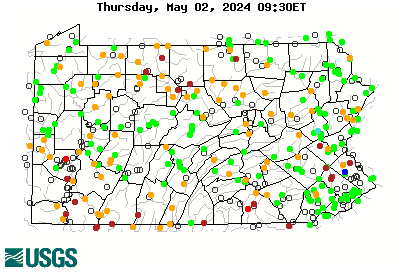Swattie87
Well-known member
- Joined
- May 3, 2011
- Messages
- 6,121
I think Pat’s point is that there likely is a token or seed population of Browns already there in many places we think they aren’t, or aren’t catching them. See the EB Fishing Creek discussion with wt2 catching Browns there for example. I was surprised by that too, but maybe I shouldn’t have been. I think this is the case more than we realize.
You also see it a lot on the streams proposed to be added to the Class A list publications, where they show you the biomass of what they shocked. I see a lot that are proposed to be listed as “Brook Trout” based on the listing criteria, but if you look at the biomass data, there will be like 1.56 kg/ha (or whatever) Browns that they found too, along with the 40+ kg/ha Brookies. Enough to be there, and begin a takeover if conditions shift to allow it, but not enough to expect to regularly catch them when fishing it amongst all the Brookies. Especially when considering Browns are generally harder to catch than Brookies. How do you get rid of those? You can’t. Even if you could shock the whole stream and remove all the Browns (which you probably can’t), the trib one ridge over that you think is all Brookies probably has a few Browns in it too, and they can just as easily swim up the stream you just removed them from. And the trib one ridge over from that, and so on. What about the trib 20 miles downstream that is connected by the bigger receiving stream? It’s surely suitable for Trout probably 8 months of the year, if not more, allowing for fish to use it to move. Plenty of evidence of this out there.
Browns are present in EVERY major watershed in PA. Small individual streams, above barriers like waterfalls or dams, or disconnected culverts, sure they exist. But the Browns are there somewhere in that watershed, I guarantee it.
I know of two instances where guys have caught clearly wild Tigers in streams where they, nor I, have ever caught a Brown Trout in. How’d the Tiger get there…?
Edit: Admittedly, there are many streams identified by the PFBC that when surveyed are ALL Brookies too. But, I guarantee there are Browns in the watershed already somewhere, and given the right conditions (PH/habitat/etc), and absent a barrier, they could get to that all Brookie stream and infiltrate it. That’s not allopatric.
You also see it a lot on the streams proposed to be added to the Class A list publications, where they show you the biomass of what they shocked. I see a lot that are proposed to be listed as “Brook Trout” based on the listing criteria, but if you look at the biomass data, there will be like 1.56 kg/ha (or whatever) Browns that they found too, along with the 40+ kg/ha Brookies. Enough to be there, and begin a takeover if conditions shift to allow it, but not enough to expect to regularly catch them when fishing it amongst all the Brookies. Especially when considering Browns are generally harder to catch than Brookies. How do you get rid of those? You can’t. Even if you could shock the whole stream and remove all the Browns (which you probably can’t), the trib one ridge over that you think is all Brookies probably has a few Browns in it too, and they can just as easily swim up the stream you just removed them from. And the trib one ridge over from that, and so on. What about the trib 20 miles downstream that is connected by the bigger receiving stream? It’s surely suitable for Trout probably 8 months of the year, if not more, allowing for fish to use it to move. Plenty of evidence of this out there.
Browns are present in EVERY major watershed in PA. Small individual streams, above barriers like waterfalls or dams, or disconnected culverts, sure they exist. But the Browns are there somewhere in that watershed, I guarantee it.
I know of two instances where guys have caught clearly wild Tigers in streams where they, nor I, have ever caught a Brown Trout in. How’d the Tiger get there…?
Edit: Admittedly, there are many streams identified by the PFBC that when surveyed are ALL Brookies too. But, I guarantee there are Browns in the watershed already somewhere, and given the right conditions (PH/habitat/etc), and absent a barrier, they could get to that all Brookie stream and infiltrate it. That’s not allopatric.
Last edited:






